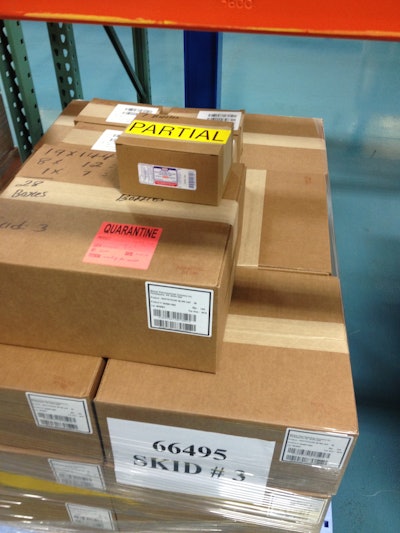
Often forgotten among all the issues addressed when preparing the serialization of a first packaging line is how to handle partial containers. Frequently the partial container is that very last packaged case for which there is not enough product to completely fill it. When this case is added to a pallet, it will end up being partial as well. This also applies to other packaging inside a case, such as bundles or trays. For the purpose of this article, we will use the case as our example.
The GS1 “GTIN and Serial Number” (widely referred to as the SGTIN (Serialized Global Trade Item Number) is the serial number format required by most regulations. For most manufacturers, the introduction of the GTIN on their labels coincides with their serialization effort. It is precisely the GTIN introduction that is the issue with partial containers.
In the GTIN structure, the first digit (called the Indicator Digit) must be different for each packaging level. This means that, for a particular product, each packaging level is labeled with a different GTIN. Also, GS1 clearly states that a GTIN must refer to a specific product type, concentration, size, and package configuration (which includes the item quantity).
Another standard, which logically follows the GTIN implementation, is the GDSN (Global Data Synchronization Network). In a nutshell, the GDSN is the standard way to store and display all the attributes of each GTIN a company manufactures, distributes, or sells. The number of children items is one of those attributes.
To summarize, the SGTIN for the case is an indication that the case is filled with the full quantity that the GTIN is intended to identify. For this reason, a GTIN—whether serialized or not—should not appear on the outside of a partial (or mixed) case. This is to ensure that a partial case is not inadvertently shipped to a trade partner (and charged as a full one).
How is the industry handling this?
At the moment, there are no clear industry-wide guidelines on how to handle partial containers in a serialized environment. Here is a list of some methods I’ve either seen deployed or that are possible:
A. SSCC Identification:
An SSCC (Serial Shipping Container Code) is an alternative to the GTIN + Serial Number format. Some of the digits are specific to a company, whereas the other digits are used to identify a unique number for each labeled package. The SSCC does not identify the product.
Even though the SSCC serial number format is meant to identify the packaging level that is shipped out (usually pallets), it is fully EPCIS (Electronic Product Code Information Services)-compatible (for the aggregation record) and, once in the warehouse, it becomes 100% clear that the partial container is "different" from the others. An SSCC allows the case and its contents to be indicated within an ASN (Advanced Shipping Notice), DPMS (Drug Pedigree Messaging Standard) e-pedigree envelope and/or EPCIS events, which is where the recipient should look for contained quantity.
B. SGTIN with a “Partial” mention
This method consists of manually adding a mention, using a label or even a marker, over or adjacent to the case label. If the Packaging Execution Solution (PES) is not able to print a different label template for a partial container, this is the least that can be done.
This method is not GS1-compliant (as the same GTIN is utilized for different package sizes). However, the “Partial” mention is meant to avoid confusion in the warehouse, where the container (as is, or split into smaller ones) will eventually get an SSCC before being shipped out. Hence the trade partners will never see the SGTIN.
C. SGTIN with Accurate Printed Quantity
This method is identical to the last one but with the accurate quantity printed on the case label.
Since a case label normally states the quantity (both in a barcode and in human-readable text), using the same label template for both complete and partial containers poses another problem. In this case, instead of only adding a “Partial” mention, printing the accurate quantity on the partial container (if the PES allows it) is a step in the right direction toward accurate printed information.
D. Different GTIN with the “9” as the indicator digit
In the GS1 rules, the GTIN Indicator Digit can be assigned any digit from “0” to “8”. The “9” is reserved to identify a container that has a variable quantity, such as a partial container. When the “9” digit is used in a GTIN, GS1 clearly specifies that the quantity, if encoded in a barcode using the “30” Application Identifier, should be the actual quantity.
This method has the same advantages as using an SSCC as it is compliant with the existing standards (both as per identification or serialized event recording) and it removes the risk of shipping a partial container marked as full.
E. No Serial Number
This method consists of simply not applying a case label on the partial containers. Only the label of an item level (e.g. a bottle label) is applied to the case in order to indicate the product type.
This is a way to stay GS1-compliant if the PES is unable to print dedicated label schemes for partial containers. An SSCC will eventually be applied before shipment.
The trouble with this approach is that all of the full cases will have a serial number (SGTIN) established at case packing time, but the partial will not have one until shipment from the DC. That might cause problems with internal track and trace.
Recommendation
Until all manufacturers align their methods so that downstream trading partners can expect consistency, methods for dealing with partial containers should be evaluated on the following criteria:
• Compliance with standards
• Avoiding wrong picking in the warehouse
• Avoiding wrong handling by the other trading partner
• Allowing track and trace from the packaging line to the warehouse.
Both methods (a) and (d) fulfill these criteria.
When a regulation agency decides to address partial containers in their guidelines, they will most likely choose the method that is most widely used. Because of this, I advocate method A. SSCC Identification. It consists of applying a dedicated label carrying an SSCC on the partial container. This method is widely utilized by manufacturers that were early adopters of serialization. This is based on my own serialization project experience, and from feedback from serialization consultants.
Figure 1 shows an example of what a partial container label could look like.
When you implement your serialization scheme, you will be glad that you took the time to think about how to handle partial containers.
--Article supplied by Jean-Pierre Allard, Serialization Manager at Optel Vision.

























